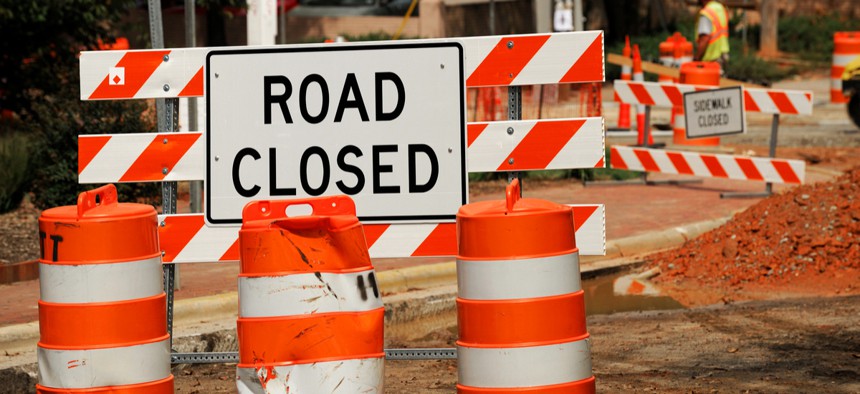Roads Suffer When States Focus on Expansion Over Repair, Report Says

Many states are overspending on expansion and underspending on repairs, a new report claims. ND700/Shutterstock
If federal leaders do work out a deal on a $2 trillion infrastructure spending package, advocacy groups say a lot of the money should go toward road repairs, rather than new highway construction.
The shameful condition of roads across the country took center stage this year during many state legislative debates. But a new report charges that state policymakers too often contributed to the ailing infrastructure, with 23 states in recent years spending more on road expansion than on needed repairs.
“Lawmakers and officials like a good ribbon cutting at a new road, but repair is too often treated like flossing teeth: A tedious, sometimes painful extra step that’s all too easily skipped. Except that it’s critical and saves taxpayers cash and pain down the road,” said Steve Ellis, executive vice president of Taxpayers for Common Sense, in a statement.
The report, written by Ellis’ group and Transportation for America, highlights the growing number of roads classified as in “poor condition,” which increased from 14% of roads in 2009 to 20% in 2017, as a common policy challenge for states. The percentage of roads labeled “poor” grew in 37 states from 2009 to 2017.
The report estimates that it would cost around $231 billion per year to keep existing roads in good condition while repairing all the “poor” roads. But that type of investment has an uncertain future, said Beth Osborne, director of Transportation for America.
“It’s a lot of money and it’s significantly more than we spend now. One of the additional challenges to getting that money is the reasonable public lack of confidence that it would be spent for that purpose,” said Osborne.
Federal government policies also contribute to the focus on building over fixing. In 2015, government highway expenditure hovered around $105 billion, with only a portion of that money allocated to repairs.
Osborne says that low spending on repairs is partially blamed on the structure of the federal highway program, which was designed to build new roads. “We’ve inherited a lot of policies that push us to build. We give DOTs a fraction of the money they need, and then say ‘do it all!’ But in establishing everything as a priority, we have established nothing is a priority,” she said.
President Trump recently reached a tentative agreement with Democratic congressional leaders on a $2 trillion federal infrastructure package. He is expected to reconvene soon with House Speaker Nancy Pelosi and Senate Minority Leader Chuck Schumer to discuss funding options for the measure.
Osborne says she’d like to see any new infrastructure package structure the highway program more like the transit program, which has flexible spending for basic maintenance. That way, if a state wants an investment from the federal government to build new roads, they have to prove that they are not forgoing other responsibilities, like maintenance.
“As it stands, states can go into debt on projects that aren’t particularly needed. And then we wonder why we have a backlog of poor roads that need to be fixed,” she said.
The report also makes note of a gap between urban and rural roads. Rural infrastructure has been a Trump administration priority, as a means to better connect rural residents to employment opportunities and vital services. But the report notes that many states spend comparably on road repairs in urban and rural areas, despite the fact that just 18% of rural roads are in poor condition while 37% percent of urban roads are. “Urban roads impact more people and see more wear and tear and therefore require more investment in upkeep—yet our spending priorities ignore this reality,” the report states.
Interestingly, states that are largely rural are leading the country in the amount of their highway budget that they dedicate to repairs. South Dakota comes first, with 69% of its budget, followed by North Dakota with 68%.
Steve Salwei, the director of transportation programs with the North Dakota Department of Transportation, said that maintaining current infrastructure is the department’s top priority. “With limited resources available we need to make sure we are making the most economical improvements to our roadways in order to meet the long term needs of the state. We have found that if you maintain your roadways on a regular basis, it costs you a lot less money than having to reconstruct them,” he said.
The outlook for those hoping more states will follow the Dakotas’ lead is mixed. The gap between spending on expansion and spending on repair has improved in recent years, but many states are still vastly overspending on expansions that they will not be able to maintain over time, the report says.
For example, states overall spent $21.3 billion on road expansion annually between 2009 and 2014, while spending about $21.4 billion on repairs. And even states that did allocate more money to maintenance often didn’t spend enough, the report says.
The emphasis on growth means that in future years states will have even more roads to maintain, and likely not enough money. Every new mile of road costs about $24,000 per year to maintain, the report estimates.
The two advocacy groups suggest a four-pronged course of action moving forward. The authors argue that the next transportation bill should set “measurable outcomes” and prioritize repairing roads in poor condition. Congress should also require that states spend highway funding on repairs before expanding their road systems, and create requirements around new roadway projects to ensure sponsors prove their ability to maintain them during long-term upkeep. Finally, they suggest that the Federal Highway Administration should have stronger public reporting standards for road performance targets.
Emma Coleman is the assistant editor for Route Fifty.
NEXT STORY: Monitoring the complex relationship between applications and servers






